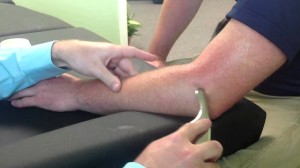How Does Soft Tissue Mobilization Work?
 Longtime athletes and coaches are constantly on the hunt for easy and effective ways to both help prevent common sports injuries as well as speed up recovery times when an injury does occur. Tactics like ice therapy, cupping, and foam rolling have all had their heyday recently, but one practice seems to have endured the longest – sports massage.
Longtime athletes and coaches are constantly on the hunt for easy and effective ways to both help prevent common sports injuries as well as speed up recovery times when an injury does occur. Tactics like ice therapy, cupping, and foam rolling have all had their heyday recently, but one practice seems to have endured the longest – sports massage.
Believed to have originated in ancient Greece and Rome where gladiators were prescribed massages both before and after working out or battling, sports massage has evolved throughout the centuries to incorporate more physiotherapy and recovery techniques. This has lent itself to a newer therapeutic approach called soft tissue mobilization.
What is Soft Tissue Mobilization (STM)?
An umbrella term to capture a wide array of techniques, soft tissue mobilization is any type of physiotherapy performed either manually or with instruments that help to release soft tissues in the body. Soft tissues are essentially any component of the musculoskeletal system that is not bone – so ligaments, tendons, muscles, skin, fat, fascia, cartilage, nerves, and so on.
Soft tissue injuries are common in sports, from sprains to muscle strains to tendonitis and other stress injuries. The healing process following a soft tissue injury involves a unique process of biological repair. An inflammation response from the body floods the tissue at first with fluids, blood, and eventually white blood cells; this causes the characteristic swelling, warmth, and redness of a fresh soft tissue injury like an ankle sprain.
The reparative phase starts next wherein blood platelets release chemicals that attract cells to the tissue to start rebuilding. A core component of this healing process is the formation of scar tissue in and around the injured area to protect it. In the final weeks or even months of recovery, the body actively remodels the injured tissue building it back stronger and re-organizing jumbled collagen and tissue fibers.
How Does Soft Tissue Mobilization Help?
While this all sounds fine and dandy, the fact of the matter is that sometimes too much scar tissue is left over. That excessive formation of fibrous tissue can alter the way the soft tissue lengthens, contracts, and moves. This may make an athlete more susceptible to re-injuring the area and can cause symptoms like:
-
Restricted range of motion
-
Weakness
-
Soft tissue misalignment
-
Pain
-
Inability to relax the tissue
That’s where soft tissue mobilization comes into play. As an interplay between physical therapy, sports massage, occupational therapy, spinal manipulation, and osteopathy, STM allows skilled and trained professionals to release restrictions in the body’s soft tissues and restore range of motion. STM offers recovery and injury-prevention benefits for conditions like tennis elbow, lateral and inner knee pain, shin splints, plantar fasciitis, rotator cuff tendonitis, torn quadriceps, sprained ankle, and hip pain.
How is Soft Tissue Mobilization Administered?
There are several different types of STM including Instrumented soft tissue mobilization where a therapist uses ergonomically-designed tools to identify and break up more abnormal soft tissues and restore proper movement. Some athletes have recently even gone so far as to use car buffers to mobilize their soft tissues in weight rooms across America.
Myofascial manipulation, on the other hand, involves targeted manipulation of the body’s soft tissues with one or two hands; it helps to break up myofascial adhesions, or inelastic tissue fibers (like scar tissue). Another type, active mobilization, also called facilitated mobilization techniques, incorporates guided movement on the athlete’s part in lengthening contracted and tight tissues with help from a therapist.
In addition to promoting recovery and even stimulating tissue regeneration, it is believed that soft tissue mobilization can boost range of motion, reduce pain, alleviate soft tissue tension and stiffness, as well as improve overall functioning. A 2006 study in The BMJ revealed that physiotherapy like soft tissue mobilization beat out corticosteroid shots and the “wait and see” method when it came to treating tennis elbow. Additional research has continued to reveal its efficacy as a treatment alternative to pharmacological aids.












